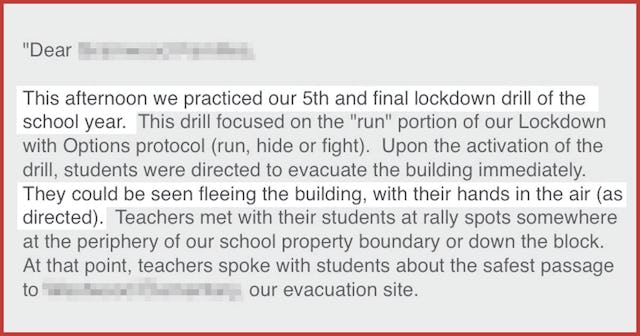My Son Spent Yesterday 'Fleeing The Building, Hands In Air' During His Lockdown Drill

Our kids shouldn’t be training to “flee the building” at school
Gun violence is a threat to every American school, but we’ve gotten to the point that each time we see a news story about a horrific shooting taking place at our schools and college campuses it becomes less and less surprising. We know our kids practice lockdown drills at school as a result, but the shock of hearing the details about our babies doing so never goes away.
“This afternoon we practiced our 5th and final lockdown drill of the school year,” my son’s school principal said in an email to parents yesterday. “This drill focused on the ‘run’ portion of our Lockdown with Options protocol (run, hide or fight). Upon the activation of the drill, students were directed to evacuate the building immediately. They could be seen fleeing the building, with their hands in the air (as directed).”
Julie Scagell
My son, a first grader, and his friends spent part of their day “fleeing the building” — a building he goes every day to learn — in case someone with a gun decides to walk into his school and start shooting at random. A friend of mine says in their school they give the kids lollipops to suck on so they learn to be quiet while hiding in their classrooms. Lollipops.
“Teachers met with their students at rally spots somewhere at the periphery of our school property boundary or down the block,” his email continued. “At that point, teachers spoke with students about the safest passage to (their) evacuation site.”
We’ve received notifications in the past that his school is moving to the “Lockdown with Options” because safety experts recommended a more proactive approach to simply hiding in a classroom bathroom or barricading a door. But to see the words written down and to picture my seven-year-old, a child who still sleeps with his baby blanket and believes in Santa, running out of his school with his hands in the air is abhorrent.
I’m in no way blaming his school for attempting to make students as safe as possible, but we’ve fallen so far as a society that parents regularly receive these sorts of updates along with information about Read-A-Thons and bake sales and must accept this as normal.
Julie Scagell
In 2018, more than four million students endured lockdown drills and the psychological impacts far exceed anything we can imagine. Children have wept openly, soiled themselves, written farewell notes to family and friends — notes that explain what to do with their toys if they die. Our teachers wonder if they’ll be forced to carry a weapon to their job or endure their own nightmare during these drills like the teachers who were told to kneel and were shot in the back with plastic pellets as preparation for a school shooting.
Since the shootings at Columbine, there have been 68 school shootings. In recent years, the average number of days between school shootings has been decreasing, now sitting at just 77 days. As a result, close to 92 percent of schools practice some sort of lockdown drill. But do they work?
A recently published review of school-based practices from 2000 to 2018 found that “none of the currently employed school firearm violence prevention methods have empirical evidence to show they actually diminish firearm violence in schools,” and often create a false sense of security. Researchers also suggested that school officials don’t give in to “political pressures to ‘do something’ when that ‘something’ is likely to be ineffective and wasteful of limited school resources.”
I certainly don’t have all the answers, but at some point fixing the actual gun problem (and for the millionth time this does not mean taking guns away from people) in our country rather than ineffective methods to try to protect our kids (and their psychological wellbeing) seems like a good place to start. This is not, and should never feel “normal.”